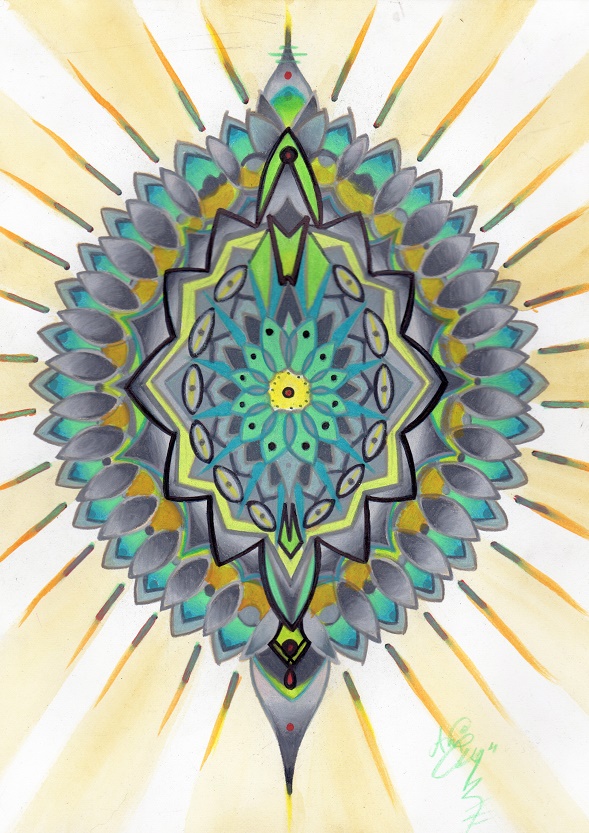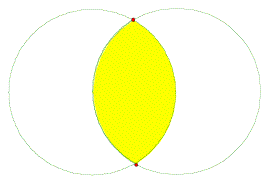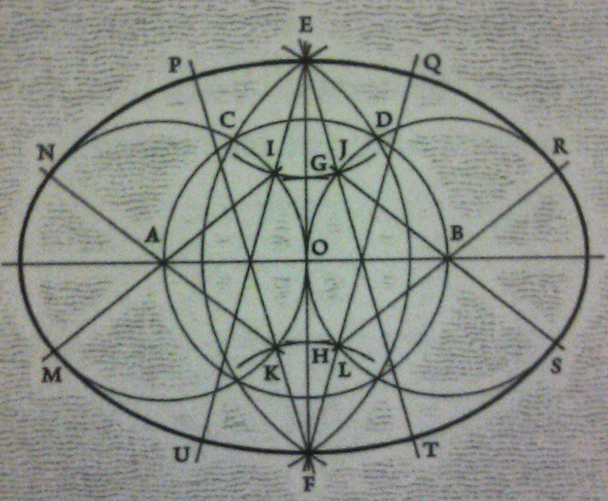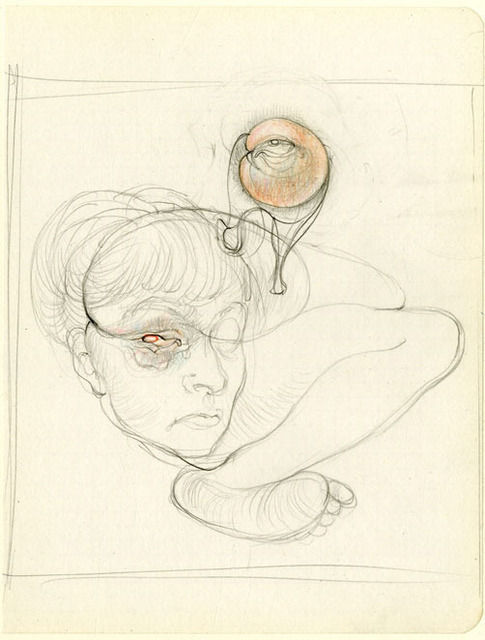Mandala, or mandorla?

mandala
I want to talk a little about why I paint and work with mandorlas rather than mandalas.
A mandala is a circular pattern, sometimes used ritually, which is built on radial symmetry. Each section of a mandala will be the same, drawing the eye into the center. The eye moves into the middle distance, being drawn past the paper or surface and off into what it perceives as a distant center. This is subconscious and happens because of the radial symmetry. We’re accustomed to seeing lines of perspective radiating from the distant horizon in art, so our eye interprets the center of a mandala as being far away (even if the artist has used every means to make it come forward at us, visually).
I think this is all fine and dandy. But-

mandorla
Mathematically speaking, a mandala is based on the circle, a single-edged shape. They are often meant to represent wholeness or unity. A triangle has three edges, a square four, and so on. Each of these shapes, symbolically speaking, have their own meaning- their own particular use. For example, the pentagram has been used as a symbol for humanity. Arms, legs, head- making a five-pointed star. The symbolism of triangles with fertility (mother, father, child) or some kind of trinity of gods, is common. A square is often used to represent a church, an institution, the law. The circle, used as it is to represent oneness (since it is a shape constructed of one line) is well known among many religious traditions.
The mandorla? It’s really only used as a backdrop. As a containing symbol for other objects. I think, though, that it can stand on its own. It’s less often used, less the subject of an image, than a circle or a triangle. Hell, even seven-pointed stars are more common than a two-sided shape. Why is this?
The mandorla, or vescica piscis, is not as often used purposely in works. Maybe because it represents the feminine energy, the vulva. Modern christians use it as the basis for the ‘jesus fish’, but it’s much older than their religion and used to be much more visible in works or ritual and religious arts. The crescent moon is just a bent mandorla; sheila na-gigs hold open a mandorla for us to peer into, and in every Venn diagram it represents the union of two concepts.

When you look at occult writing or at geometry books, it’s usually not even mentioned. They’ll skip right from the number 1, the circle, to number 3, the triangle- without even acknowledging that they’ve skipped over 2.
When constructing a repeating mandorla, Each section will be different. Each segment is a different shape and size, if you use radial symmetry to plot it. Using the technique of construction that you’d use on a mandala, a mandorla will be symmetrical only on one axis. Each radial section will change in proportion, from top to center. This means that there are stopping points for the eye, which instead of being drawn to the center will also notice the vertical and move more freely around the interior of the work.

 To me, the mandorla is the eye, an eye. I know that it’s traditionally a vulva, and that most people, when asked what the shape is, will say so (if they don’t say “venn diagram” or “jesus fish” first). But to me it is an eye.
To me, the mandorla is the eye, an eye. I know that it’s traditionally a vulva, and that most people, when asked what the shape is, will say so (if they don’t say “venn diagram” or “jesus fish” first). But to me it is an eye.
There’s a series of works by Hans Bellmer illustrating the book The Story of the Eye (by Bataille) which first started me thinking about mandorlas many years ago. Bellmer, and Bataille, were surrealists. They believed that their works would bring meaningful content from the subconscious world of dreams, and I think in this case the symbol of the eye in the vagina is a potent one.
There was a recent study which showed that people will be less aggressive and less likely to ‘misbehave’ if there is an eye in their environment. This does not have to be a person watching them- in fact, just a simple mandorla shape with a circle inside it, the absolute simplest representation of an eye, will have this effect. This has been tested in various ways, usually with the same result- people steal less often and harm each other less often when their subconscious tells them they are being watched. It’s similar to telling children god can always see them- it appeals to the conscience. It can also be a bit disturbing or eerie to feel watched. I’d like these pieces to reflect both of these concepts and see what else they can bring to light.
There’s something to be said, also, for using a traditionally feminine symbol, a vulva, as the way to present an eye looking back at the viewer. With so much sexual assault against women, and so many attacks on the feminine, in general, around the world, I feel that this symbol also stands in for a witness to these things. We’ve come far in many ways in our discussion of these issues, but there’s still a lack of authority for women’s voices, for testimony and witness from women, that needs addressing. I don’t think about all these things as I work, of course. I think about them before and after, and this is the best explanation I’ve come up with for my desire to draw these shapes, and not circular mandalas.

(you can find prints of my mandorla works at this link, and the rest of my work here.)
